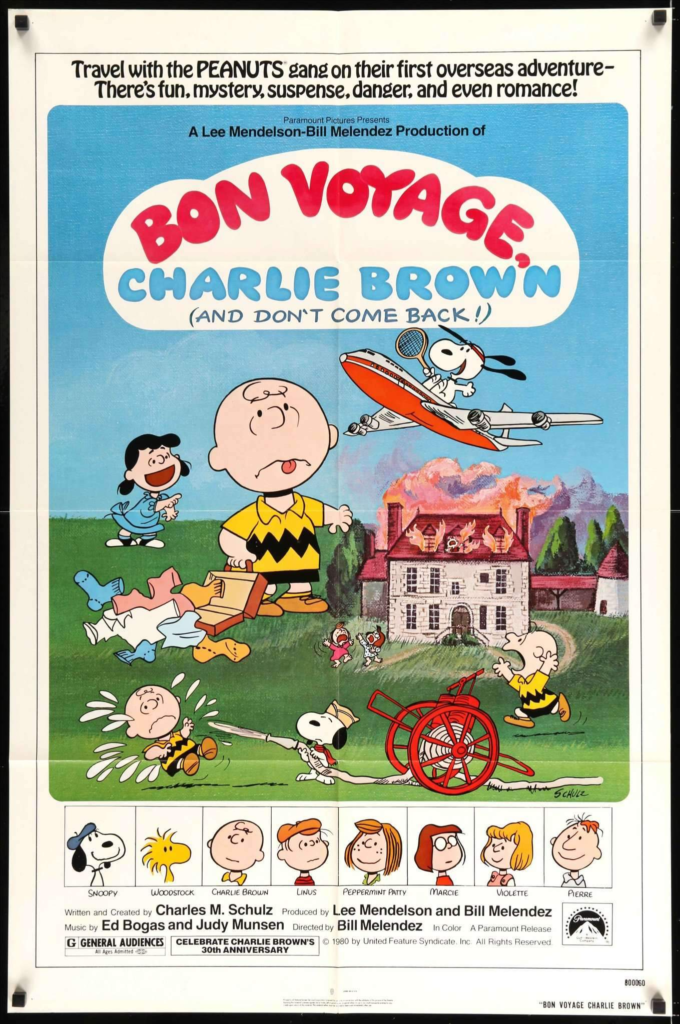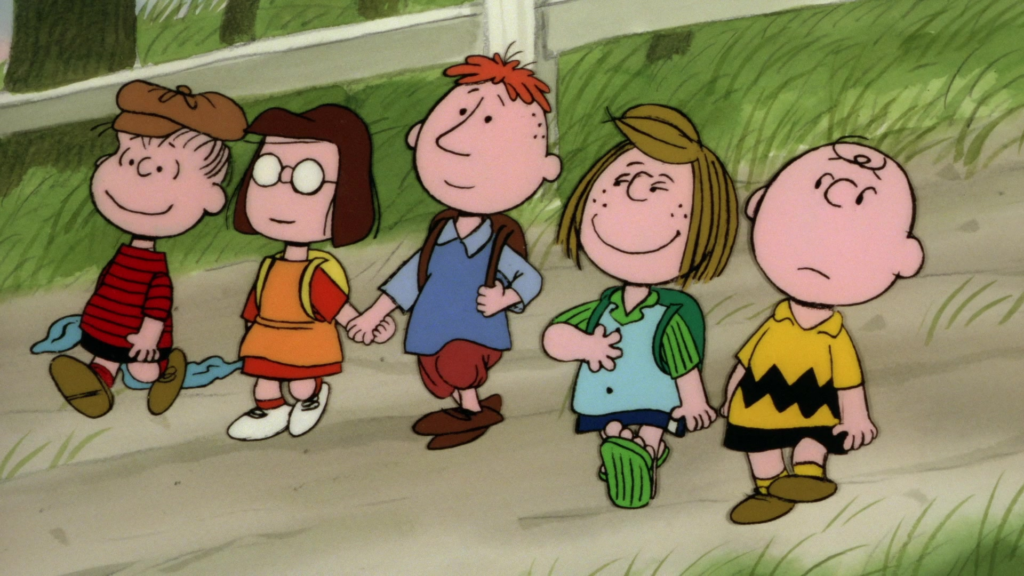Free as Running Water, Fresh as Morning Dew: Race For Your Life, Charlie Brown (1977)

The first line of this movie’s opening song is “it’s a new day,” and that’s appropriate since the third Peanuts film represents a lot of firsts for them. It was the first to be produced by Paramount Pictures rather than Cinema Center Films. It was first to have two directors, Bill Melendez and Peanuts animation veteran Phil Roman. It was the first to introduce antagonists who weren’t from the comic strip[1]Well, Snoopy Come Home did have Clara but she was only in one scene. and the first to have life and death stakes. The story puts the Peanuts kids on a bus to a remote wilderness survival camp with Snoopy and Woodstock in tow on a motorcycle. There they are pitted against a trio of bullies (voiced by Kirk Jue, Jordan Warren and Tom Muller) and their fearsome cat on a dangerous three-day river rift race. The bullies have a ridiculously high tech “raft” compared to those of their competitors and absolutely no qualms about cheating or even about endangering people’s lives. (And, no, they don’t receive any discipline. Whoever runs this camp really believes in letting kids rough it.)

Another first is that while the comic strip had sent the gang to summer camp many a time, the entire of story of Race For Your Life and nearly all of the jokes are original to it. A Boy Named Charlie Brown and Snoopy Come Home, by contrast, had taken storylines from the comics and expanded on them, making them more dramatic. But while more dramatic, they were still arguably the exact kind of stories you’d expect from Peanuts. I’d argue that was exactly what they should have done for their debut on a new medium. But after two movies, it was time for something new and Race For Your Life delivers with a much more adventurous and suspenseful tale, one that’s not as good of an introduction to the characters for newcomers but is arguably more fun for longtime fans.
Like Snoopy Come Home, this movie marks the big screen debut for some characters who had only appeared in the newspaper and on television. Peppermint Patty (Stuart Brotman)’s foil, Marcie (Jimmy Ahrens), is a highly welcome presence here. There’s also Franklin (Joseph Biter)[2]Well, technically, his big screen debut was a wordless cameo in Snoopy Come Home. though he only has one line of dialogue and basically exists to even out the girls’ cabin and the boys’ cabin.[3]I’d call Franklin the token minority but that wouldn’t be fair since when he was introduced in the comic strip, having an African American character actually was kind of daring, though … Continue reading Actually, Schroeder (Greg Felton) doesn’t get much to say or do either.


This film was released toward the end of the Golden Age of Peanuts animation.[4]That’s not to say the specials that afterwards were bad, just that they weren’t as consistently high quality. At first glance-first glance, mind you-it seems like a stepdown from Snoopy Come Home and A Boy Named Charlie Brown. There are some nice touches in the backgrounds, mainly the mountains and the trees, but the visuals aren’t as attractive as in the previous two movies. I know that to the casual viewer’s eye all Peanuts animation looks the same and they’re probably laughing at me right now, but what can I say? I rewatched Race For Your Life a few days after rewatching Snoopy Come Home and that’s the impression I got.

The soundtrack by Ed Bogas isn’t quite as great as those of the first two Peanuts movies either, though that opening song is a favorite of mine. And the voice acting isn’t as consistently great either.
But somehow this movie is more fun, if not, strictly speaking, better than its predecessors. I can’t quite put my finger on what makes that so. It just is. I mean, one of the first things that happens in it is Snoopy doing an Evel Knievel impression. How does that not convey fun?

This was also the first Peanuts movie to really utilize Sally Brown (Gail Davis) to her best advantage. I’ve criticized Davis’s performance as Sally in the past, but I don’t mind her here. The character’s constant carping throughout the movie is a hoot.

I also love the running gag of the girls’ cabin voting on everything, which actually gets a satisfying dramatic payoff. Speaking of drama, emotions don’t run as high in this movie as they do in A Boy Named Charlie Brown or Snoopy Come Home. That’s part of what makes it fun. But Race For Your Life does have a quiet heart beating in its metaphorical chest. Early on, Charlie Brown (Duncan Watson) confesses that he came to camp because he “never felt like much of a person” and he hoped that the experience would make him more of a leader. The race gives him his chance and…well, I’m not going to tell you.[5]Not in this post anyway. The movie is great enough that I don’t want to spoil it for newcomers.

I Want to Remember This: Bon Voyage, Charlie Brown (and don’t come back!!) (1980)

In many ways, the fourth Peanuts movie follows in the footsteps of the third one with another story that’s more adventurous than typical for the franchise and one that takes the characters even further out of their comfort zone-right, out of the country in fact. True, A Boy Named Charlie Brown and Snoopy Come Home also had the characters leave their neighborhood to go on journeys, but those movies spent time in that familiar neighborhood first, showing the characters doing familiar Peanuts things. When the journeys began, it was more of a contrast. With Race For Your Life and Bon Voyage, Charlie Brown, the journeys are the main dish.
In other ways, Bon Voyage, Charlie Brown maps out its own territory. The first three entries in this series began with peppy music and eye-catching opening credits that showcased the beloved Peanuts characters.[6]Well, technically, A Boy Named Charlie Brown began with a dreamy romantic scene that quickly became a farce and then had the eye-catching credits scene. Bon Voyage, by contrast, opens at night somewhere in the French countryside. As rain falls, a shadowy figure in a car leaves the local cafe and returns to a gloomy chateau. The only light in the house comes from a room where a little girl (Roseline Reubens) is writing a letter. It’s a very moody atmospheric beginning that rouses your curiosity.


Then we cut to America where Charlie Brown (Arrin Skelley), Linus (Daniel Anderson), Peppermint Patty (Patricia Patts, one of the few actual girls to voice the character) and Marcie (Jimmy Ahrens again) have been selected to go to Europe as foreign exchange students with Snoopy and Woodstock tagging along as usual. Before he leaves, Charlie Brown receives a letter. That in itself is unusual for him, but what’s really mysterious is that the letter is written in French. (If you’re intrigued already and want to wait until you watch the movie to find out more, skip the rest of this paragraph.) On the plane, Marcie translates the message for Charlie Brown. It’s from someone named Violette who claims she’s heard all about C.B., is eager to meet him and invites him to stay at the Chateau du Mal Voisin e.g. the Chateau of the Bad Neighbor.

This setup recalls Lila’s letter from Snoopy Come Home but in that movie while everyone else was at a loss as to what was going on, Snoopy clearly understood. What’s more, fans who had been following Peanuts in the newspaper would have known her identity. With Violette and her letter, we’re totally in the dark and once the gang reaches France, the mystery and suspense deepen. This movie introduces a villain, the Baron (Scott Beach who voices all the offscreen adults in the film), who’s far more intimidating than the three bullies from Race For Your Life, Charlie Brown or even their cat. The fact that we don’t get a good look at him, though a better look than we usually get of adults in Peanuts, initially serves to make him even creepier.

Unfortunately, it also backfires in the end, making a final confrontation between him and our heroes impossible. While the mystery of Violette and why she invited Charlie Brown is resolved in a satisfactory way, the resolution of the conflict with the Baron is a disappointment. It involves a climactic action scene that’s exciting in that it’s far more dramatic than typical for Peanuts but not very exhilarating or well staged when compared to cinematic action scenes in general.
Not helping is that this movie is a good candidate for being the least funny Peanuts movie. Fortunately, there’s a difference between being the least funny Peanuts movie and not being funny at all. Humorous highlights include Charlie Brown’s panic attack having to show his passport, Snoopy’s John McEnroe impression at Wimbledon, the announcer’s outraged response to his tantrum[7]This film has an unusually large amount of intelligible dialogue from adults for Peanuts. and Peppermint Patty thinking her host, Pierre (Pascale de Barolet), is attracted to her when he’s clearly interested in Marcie.



Bon Voyage, Charlie Brown is worth a look for completists and the curious but there’s no escaping the feeling that its premise had potential to which it frustratingly does not fulfill.

Next Time: Charlie Brown and Company are Animated by Computer. Good Grief!
References
| ↑1 | Well, Snoopy Come Home did have Clara but she was only in one scene. |
|---|---|
| ↑2 | Well, technically, his big screen debut was a wordless cameo in Snoopy Come Home. |
| ↑3 | I’d call Franklin the token minority but that wouldn’t be fair since when he was introduced in the comic strip, having an African American character actually was kind of daring, though less so by the time this movie was made. |
| ↑4 | That’s not to say the specials that afterwards were bad, just that they weren’t as consistently high quality. |
| ↑5 | Not in this post anyway. |
| ↑6 | Well, technically, A Boy Named Charlie Brown began with a dreamy romantic scene that quickly became a farce and then had the eye-catching credits scene. |
| ↑7 | This film has an unusually large amount of intelligible dialogue from adults for Peanuts. |
